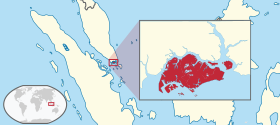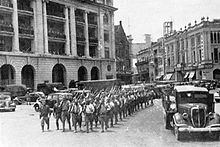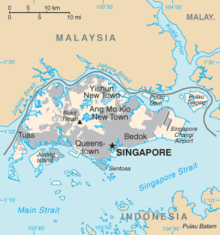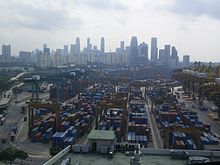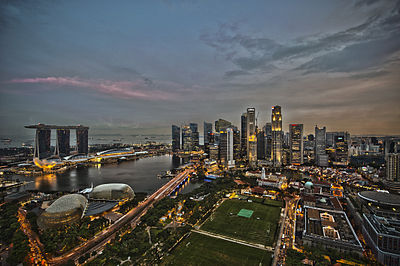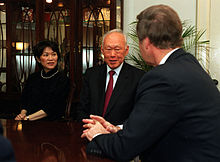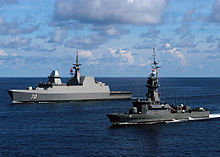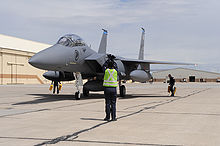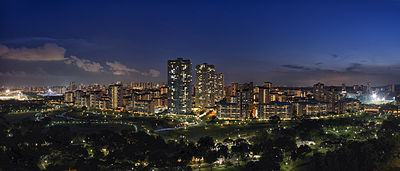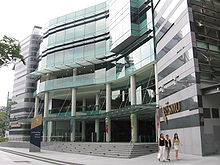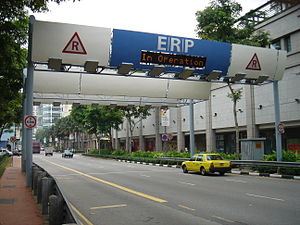
Singapore
Background Information
The articles in this Schools selection have been arranged by curriculum topic thanks to SOS Children volunteers. With SOS Children you can choose to sponsor children in over a hundred countries
|
Coordinates: 1.3°N 103.8°E
|
||||||||||||||||||||||||||||||||||||||||||||||||||||||||||||||||||||||||||||||||||||||||||||||||||||||||||||||||||||||||||||||||||||||||
Singapore / ˈ s ɪ ŋ ə p ɔr /, officially the Republic of Singapore, is a Southeast Asian island city-state off the southern tip of the Malay Peninsula, 137 kilometres (85 mi) north of the equator. An island country made up of 63 islands, it is separated from Malaysia by the Straits of Johor to its north and from Indonesia's Riau Islands by the Singapore Strait to its south. The country is highly urbanised with very little primary rainforest remaining, although more land is being created for development through land reclamation.
Part of various local empires since being inhabited in the second century AD, Singapore hosted a trading post of the East India Company in 1819 with permission from the Johor Sultanate. The British obtained sovereignty over the island in 1824 and Singapore became one of the British Straits Settlements in 1826. Occupied by the Japanese in World War II, Singapore declared independence, uniting with other former British territories to form Malaysia in 1963, although it was separated from Malaysia two years later. Since then, it has had a massive increase in wealth, and is one of the Four Asian Tigers.
Singapore is the world's fourth-leading financial centre, and its port is one of the five busiest ports in the world. The economy depends heavily on exports and refining imported goods, especially in manufacturing, which constituted 26% of Singapore's GDP in 2005. In terms of purchasing power parity, Singapore has the third highest per capita income in the world.
Singapore is a unitary multiparty parliamentary republic with a Westminster system of unicameral parliamentary government. The People's Action Party has won every election since self-government in 1959. Slightly over five million people live in Singapore, of which 2.91 million were born locally. The population is highly diverse; the majority are Chinese with almost 75% of the total population, while Malays and Indians forming significant minorities. Reflecting this diversity, the country has four official languages: English, Chinese, Malay, and Tamil. One of the five founding members of the Association of South East Asian Nations (ASEAN), the country is also the host of the APEC Secretariat, and a member of the East Asia Summit, the Non-Aligned Movement, and the Commonwealth.
Etymology
The English name of Singapore is derived from the Malay word Singapura (Sanskrit: सिंहपुर, Sinhala: සිංහපුර,literally Lion City), hence the customary reference to the nation as the Lion City. Lions probably never lived there; the beast seen by Sang Nila Utama, who founded and named ancient Singapore, was most likely a tiger.
History
The earliest known settlement on Singapore was in the second century AD. It was an outpost of the Sumatran Srivijaya empire, named Temasek ('sea town'). Between the 16th and early 19th centuries, it was part of the Johor Sultanate. In 1613, Portuguese raiders burnt down the settlement and the island sank into obscurity for the next two centuries.
In 1819, Thomas Stamford Raffles arrived and signed a treaty with Sultan Hussein Shah of Johor on behalf of the British East India Company to develop the southern part of Singapore as a British trading post. In 1824, the entire island became a British possession under a further treaty with the Sultan and the Temenggong. In 1826, it became part of the Straits Settlements, under the jurisdiction of British India. Singapore became the capital of the Straits Settlements in 1836. Before Raffles arrived, there were around 1,000 people living in Singapore, mostly indigenous Malay community, and 20-30 Chinese. By 1860, the population exceeded 80,000, with over half of the population being Chinese. Many immigrants came to work at rubber plantations, and after the 1870s the island became a global centre for rubber exports.
During World War II, the Imperial Japanese Army invaded Malaya culminating in the Battle of Singapore. The British were defeated, and surrendered on 15 February 1942. British Prime Minister Winston Churchill called this "the worst disaster and largest capitulation in British history". The Sook Ching massacre of ethnic Chinese after the fall of Singapore claimed between 5,000 and 25,000 lives. The Japanese occupied Singapore until the British repossessed it in September 1945 after the Japanese surrender.
Singapore's first general election in 1955 was won by the pro-independence David Marshall, leader of the Labour Front. Demanding complete self-rule he led a delegation to London but was turned down by the British. He resigned when he returned and was replaced by Lim Yew Hock, whose policies convinced Britain to grant Singapore full internal self-government for all matters except defence and foreign affairs.
During the May 1959 elections, the People's Action Party won a landslide victory. Singapore had become an internally self-governing state within the Commonwealth, with Lee Kuan Yew as the first Prime Minister. Governor Sir William Allmond Codrington Goode served as the first Yang di-Pertuan Negara ("Head of State"), and was succeeded by Yusof bin Ishak who in 1965 became the first President of Singapore. During the 1950s Communists, mostly supported by the Chinese-speaking group, with strong ties to the trade unions and Chinese schools, carried out an armed struggle against the state, resulting in the Malayan Emergency and later, the Communist Insurgency War. The 1954 National Service Riots, Chinese middle schools riots and Hock Lee bus riots in Singapore were all linked to the Communists.
On 31 August 1963, Singapore declared independence from Britain and joined with Malaya, Sabah and Sarawak to form the new Federation of Malaysia as the result of the 1962 Merger Referendum. Singaporean leaders joined Malaysia for various reasons. Firstly, as a small country, they did not believe that the British would find it viable for Singapore to become independent by itself. Secondly, they also did not believe that Singapore could survive on its own, due to scarcity of land, water, markets and natural resources. And lastly, the Singapore government wanted the help of the Malaysian government to flush out the Communists. The two years that Singapore spent as part of Malaysia were filled with strife and bitter disagreements. The Malaysians insisted on a pro-Bumiputera (Malay for indigenous) society, where indigenous Malays and tribes were given special Bumiputera rights, which still exist to this day to assist the majority Malay community who were left behind in terms of economic share of the country compared to the minority Chinese and to maintain harmony within a multiethnic society. The Malaysians were also suspicious about Singapore's majority of ethnic Chinese and worried that Singapore's economic clout would shift the centre of power from Kuala Lumpur to Singapore. There were also linguistic and religious issues. The Singaporeans, on the other hand, wanted an equal and meritocratic society, a Malaysian Malaysia where all citizens were given equal rights. As part of Malaysia, Singapore's economic and social development came to a halt as the Malaysian parliament blocked many bills. Race riots broke out in Singapore in 1964. After much heated ideological conflicts between the two governments, in 1965, the Malaysian parliament voted 126 to 0 to expel Singapore from Malaysia. Race riots broke out once more in 1969.
Singapore gained independence as the Republic of Singapore (remaining within the Commonwealth) on 9 August 1965 with Yusof bin Ishak as president and Lee Kuan Yew as Prime Minister. Everyone who was present in Singapore on the date of independence was offered Singapore citizenship. In 1967, it helped found the Association of Southeast Asian Nations and in 1970 it joined the Non-aligned movement. In 1990, Goh Chok Tong succeeded Lee as Prime Minister. During his tenure the country faced the 1997 Asian Financial Crisis, the 2003 SARS outbreak and terrorist threats posed by Jemaah Islamiyah. In 2004, Lee Hsien Loong, the eldest son of Lee Kuan Yew, became the country's third prime minister.
Government and politics
Singapore is a parliamentary republic with a Westminster system of unicameral parliamentary government representing constituencies. Its constitution establishes representative democracy as its political system. Freedom House ranks Singapore as "partly free" in its Freedom in the World report, and The Economist ranks Singapore as a "hybrid regime", the third rank out of four, in its " Democracy Index". Singapore is consistently rated one of the least corrupt countries in the world by Transparency International.
Executive power rests with the Cabinet, led by the Prime Minister, and the President. The president is elected through popular vote, and has some veto powers for a few key decisions such as the use of the national reserves and the appointment of judges, but otherwise occupies a ceremonial post.
The Parliament serves as the legislative branch of government. Members of Parliament (MPs) consist of elected, non-constituency and nominated members. Elected MPs are voted into parliament on a " first-past-the-post" (plurality) basis and represent either single-member or group-representation constituencies. The People's Action Party has won control of Parliament with large majorities in every election since self-governance was secured in 1959. However, in the most recent parliamentary elections in 2011, the opposition, led by the Workers' Party, made significant gains and increased its representation in the House to 6 elected MPs.
The legal system of Singapore is based on English common law, albeit with substantial local differences. Trial by jury was entirely abolished in 1970 leaving judicial assessment performed wholly by judgeship. Singapore has penalties that include judicial corporal punishment in the form of caning for rape, rioting, vandalism, and some immigration offences. There is a mandatory death penalty for murder, and for certain drug-trafficking and firearms offences. Amnesty International has said that some legal provisions conflict with the right to be presumed innocent until proven guilty, and that Singapore has "possibly the highest execution rate in the world relative to its population". The government has disputed Amnesty's claims. In a 2008 survey, international business executives believed Singapore, along with Hong Kong, had the best judicial system in Asia. In 2011, in the World Justice Project's Rule of Law Index Singapore was ranked in the top countries surveyed in "Order and Security", "Absence of Corruption", and "Effective Criminal Justice". However, it scored very low for both "Freedom of Speech" and "Freedom of Assembly". All public gatherings of five or more people require police permits, and protests may only be legally held at Speakers' Corner.
Geography
Singapore consists of 63 islands, including the main island, widely known as Singapore Island but also as Pulau Ujong. There are two man-made connections to Johor, Malaysia: the Johor–Singapore Causeway in the north, and the Tuas Second Link in the west. Jurong Island, Pulau Tekong, Pulau Ubin and Sentosa are the largest of Singapore's smaller islands. The highest natural point is Bukit Timah Hill at 166 m (545 ft).
There are ongoing land reclamation projects, which have increased Singapore's land area from 581.5 km2 (224.5 sq mi) in the 1960s to 704 km2 (272 sq mi) today; it may grow by another 100 km2 (40 sq mi) by 2030. Some projects involve merging smaller islands through land reclamation to form larger, more functional islands, as with Jurong Island. 5% of Singapore's land is set aside as nature reserves. Urbanisation has eliminated most primary rainforest on the main island, Bukit Timah Nature Reserve being the only significant remaining forest.
Singapore has a tropical rainforest climate ( Köppen: Af ) with no distinctive seasons, uniform temperature and pressure, high humidity, and abundant rainfall. Temperatures usually range from 23 to 32 °C (73 to 90 °F). Relative humidity averages around 79% in the morning and 73% in the afternoon. April and May are the hottest months, with the wetter monsoon season from November to January. From July to October, there is often haze caused by bush fires in neighbouring Indonesia. Although Singapore does not observe daylight saving time, it follows time zone GMT+8, one hour ahead of its geographical location.
| Climate data for Singapore | |||||||||||||
|---|---|---|---|---|---|---|---|---|---|---|---|---|---|
| Month | Jan | Feb | Mar | Apr | May | Jun | Jul | Aug | Sep | Oct | Nov | Dec | Year |
| Record high °C (°F) | 34.3 (93.7) |
35.2 (95.4) |
36.0 (96.8) |
35.8 (96.4) |
35.4 (95.7) |
35.0 (95) |
34.0 (93.2) |
34.2 (93.6) |
34.3 (93.7) |
34.6 (94.3) |
34.2 (93.6) |
33.8 (92.8) |
36.0 (96.8) |
| Average high °C (°F) | 30.1 (86.2) |
31.2 (88.2) |
31.6 (88.9) |
31.7 (89.1) |
31.6 (88.9) |
31.3 (88.3) |
30.9 (87.6) |
30.9 (87.6) |
30.9 (87.6) |
31.1 (88) |
30.6 (87.1) |
30.0 (86) |
31.0 (87.8) |
| Average low °C (°F) | 23.3 (73.9) |
23.6 (74.5) |
23.9 (75) |
24.4 (75.9) |
24.8 (76.6) |
24.8 (76.6) |
24.6 (76.3) |
24.5 (76.1) |
24.2 (75.6) |
24.1 (75.4) |
23.7 (74.7) |
23.5 (74.3) |
24.1 (75.4) |
| Record low °C (°F) | 19.4 (66.9) |
19.7 (67.5) |
20.2 (68.4) |
20.7 (69.3) |
21.2 (70.2) |
20.8 (69.4) |
19.7 (67.5) |
20.2 (68.4) |
20.7 (69.3) |
20.6 (69.1) |
21.1 (70) |
20.6 (69.1) |
19.4 (66.9) |
| Rainfall mm (inches) | 243.2 (9.575) |
159.9 (6.295) |
185.7 (7.311) |
178.9 (7.043) |
171.3 (6.744) |
162.1 (6.382) |
158.7 (6.248) |
175.4 (6.906) |
169.2 (6.661) |
193.8 (7.63) |
256.9 (10.114) |
287.4 (11.315) |
2,342.5 (92.224) |
| Avg. rainy days | 15 | 11 | 14 | 15 | 15 | 13 | 13 | 14 | 14 | 16 | 19 | 19 | 178 |
| % humidity | 84.7 | 82.8 | 83.8 | 84.8 | 84.4 | 83.0 | 82.8 | 83.0 | 83.4 | 84.1 | 86.4 | 86.9 | 84.2 |
| Mean monthly sunshine hours | 173.6 | 183.6 | 192.2 | 174.0 | 179.8 | 177.0 | 189.1 | 179.8 | 156.0 | 155.0 | 129.0 | 133.3 | 2,022.4 |
| Percent possible sunshine | 47 | 54 | 52 | 48 | 48 | 49 | 51 | 48 | 43 | 42 | 36 | 36 | 46.2 |
| Source #1: National Environment Agency (Temp 1929-1941 and 1948-2011, Rainfall 1869-2011, Humidity 1929-1941 and 1948-2011, Rain days 1891-2011) | |||||||||||||
| Source #2: Hong Kong Observatory (sun only, 1982—2008) | |||||||||||||
Economy
Before independence in 1965, Singapore was the capital of the British Straits Settlements, a Crown Colony. It was also the main British naval base in East Asia. Because of its status as the main British naval base in the region, as well as hosting the largest dry dock in the world at that time in the form of the Singapore Naval Base, it was described in the press as the 'Gibraltar of the East'. The opening of the Suez Canal in 1869 caused global trade to boom, and Singapore became a major world trade node, and the Port of Singapore became one of the largest and busiest ports in the world. Before independence in 1965, Singapore had a GDP per capita of $511, then the third-highest in East Asia. After independence, foreign direct investment and a state-led drive for industrialisation based on plans by Goh Keng Swee and Albert Winsemius created a modern economy.
Today, Singapore has a highly developed market-based economy, based historically on extended entrepôt trade. Along with Hong Kong, South Korea and Taiwan, Singapore is one of the original Four Asian Tigers. The Singaporean economy is known as one of the freest, most innovative, most competitive, and most business-friendly. The 2011 Index of Economic Freedom ranks Singapore as the second freest economy in the world, behind Hong Kong. According to the Corruption Perceptions Index, Singapore is consistently ranked as one of the least corrupt countries in the world, along with New Zealand and the Scandinavian countries.
Singapore is the 14th largest exporter and the 15th largest importer in the world. The country has the highest trade-to-GDP ratio in the world at 407.9 percent, signifying the importance of trade to its economy. The country is currently the only Asian country to have AAA credit ratings from all three major credit rating agencies – Standard & Poor's, Moody's, and Fitch. Singapore attracts a large amount of foreign direct investment as a result of its location, corruption-free environment, skilled workforce, low tax rates and advanced infrastructure. There are more than 7,000 multinational corporations from the United States, Japan, and Europe in Singapore. There are also 1,500 companies from China and 1,500 from India. Foreign firms are found in almost all sectors of the economy. Singapore is also the second largest foreign investor in India. Roughly 44 percent of the Singaporean workforce is made up of non-Singaporeans. Over ten free trade agreements have been signed with other countries and regions.
Singapore also possesses the world's eleventh largest foreign reserves. The currency of Singapore is the Singapore dollar, issued by the Monetary Authority of Singapore. It is interchangeable with the Brunei dollar.
The Singaporean economy depends heavily on exports and refining imported goods, especially in manufacturing, which constituted 27.2% of GDP in 2010 and includes significant electronics, petroleum refining, chemicals, mechanical engineering and biomedical sciences sectors. In 2006 Singapore produced about 10% of the world's foundry wafer output. Despite its small size, Singapore has a diversified economy, a strategy that the government considers vital for growth and stability.
Tourism also forms a large part of the economy, and 10.2 million tourists visited the country in 2007. To attract more tourists, in 2005 the government legalised gambling and allowed two casino resorts (called Integrated Resorts) to be developed. Singapore is promoting itself as a medical tourism hub: about 200,000 foreigners seek medical care there each year, and Singapore medical services aim to serve one million foreign patients annually by 2012 and generate USD 3 billion in revenue. Singapore is an education hub, and many foreign students study in Singapore. Singapore hosted over 80,000 international students in 2006. There are also more than 5000 Malaysian students who cross the Johor–Singapore Causeway every morning with hopes of receiving a better education in Singapore. In 2009, 20% of all students in Singaporean universities were international students. The students were mainly from ASEAN, China and India.
Singapore is a world leader in several economic areas: The country is the world's fourth leading financial centre, the world's second-biggest casino gambling market, one of the world's top three oil refining centres, the world's largest oil-rig producer, and a major ship-repairer. The port is one of the five busiest ports in the world. The World Bank has named Singapore as the easiest place in the world to do business and ranks Singapore the world's top logistics hub. It is also the world's fourth largest foreign-exchange trading centre after London, New York and Tokyo.
As a result of global recession and a slump in the technology sector, Singapore's GDP contracted by 2.2% in 2001. The Economic Review Committee was set up in December 2001 and recommended several policy changes to revitalise the economy. Singapore has since recovered, due largely to improvements in the world economy; the economy grew by 8.3% in 2004, 6.4% in 2005, and 7.9% in 2006. After a contraction of 0.8% in 2009, the economy recovered in 2010, with GDP growth of 14.5%. Most work in Singapore is in the service sector, which employed 2,151,400 people out of 3,102,500 jobs in December 2010. The percentage of unemployed economically active people above age 15 is about 2%.
Singapore has the world's highest percentage of millionaires, with one out of every six households having at least one million US dollars in disposable wealth. This excludes property, businesses, and luxury goods, which if included would further increase the number of millionaires, especially as property in Singapore is among the world's most expensive. Despite its relative economic success, Singapore does not have a minimum wage, believing that it would lower its competitiveness. It also has one of the highest income inequality levels among developed countries, coming in just behind Hong Kong and in front of the United States.
Acute poverty is rare in Singapore; the government has rejected the idea of a generous welfare system, stating that each generation must earn and save enough for its entire life cycle. There are, however, numerous means-tested 'assistance schemes' provided by the Ministry of Community Development, Youth and Sports in Singapore for the needy, including some that pay out SGD 400 to SGD 1000 per month to each needy household, free medical care at government hospitals, money for children's school fees, rental of studio apartments for SGD 80 a month, training grants for courses, etc. Also, Singapore is rated top in terms of net international investment position per capita.
In April 2013, the country was recognised as an increasingly popular tax haven for the wealthy due to the low tax rate on personal income, a full tax exemption on income that is generated outside of Singapore and legislation that means that capital gains are also tax exempt. Australian millionaire retailer Brett Blundy, with an estimated personal wealth worth AU$835 million dollars, and multi-billionaire Facebook co-founder Eduardo Saverin are two examples of wealthy individuals who have settled in Singapore (Blundy in 2013 and Saverin in 2012).
Foreign relations
Singapore's foreign policy is directed to maintaining a secure environment in Southeast Asia as well as the surrounding territories. An underlying principle is political and economic stability in the region. It has diplomatic relations with 175 other sovereign states. As one of the five founding members of the ASEAN, the country is a strong supporter of the ASEAN Free Trade Area and the ASEAN Investment Area, because Singapore's economic growth is closely linked with the economic progress of the region as a whole. Former Prime Minister Goh Chok Tong proposed the formation of an ASEAN Economic Community, a step beyond the current AFTA bringing it closer to a common market. This idea was agreed to in 2007 for implementation by 2015. Other regional organisations are also important to Singapore, and it is the host of the APEC Secretariat. Singapore also maintains membership in other regional organisations, such as Asia-Europe Meeting, the Forum for East Asia-Latin American Cooperation, and the East Asia Summit. It is also a member of the Non-Aligned Movement and the Commonwealth.
In general, bilateral relations with other ASEAN members are strong; however, disagreements have arisen, and relations with neighbouring Malaysia and Indonesia have historically sometimes been very strained and difficult. Malaysia and Singapore have clashed over the delivery of fresh water to Singapore, access of the Singapore Armed Forces to Malaysian airspace, the sovereignty of Pedra Branca, and the relocation of Tanjong Pagar railway station, among others. Border issues exist with both Malaysia and Indonesia, and both have banned the sale of marine sand to Singapore over disputes about Singapore's land reclamation. Some previous disputes have been resolved by the International Court of Justice. Piracy in the Malacca Strait has been a cause of concern for all three countries. Close economic ties exist with Brunei, and the two share a pegged currency value.
The first diplomatic contact with China was made in the 1970s, with full diplomatic relations being established in the 1990s. Since then the two countries have enjoyed a strong relationship, being major players in strengthening the ASEAN–China relationship. Singapore and the United States share a long-standing and strong relationship, in particular in defence, the economy, health and education. The United States was Singapore's third largest trading partner in 2010, behind the European Union and China. The two countries have a free-trade agreement, and Singapore views its relationship with the United States as an important counterbalance to China's influence. A Strategic Framework Agreement between the two signed in 2005 formalises security and defence cooperation. Singapore has pushed regional counter-terrorism initiatives, with a strong resolve to deal with terrorists inside its borders. To this end it has given support to the US-led coalition to fight terrorism, with bilateral cooperation in counter-terrorism and counter-proliferation initiatives, and joint military exercises.
Military
The Singaporean military is arguably the most technologically advanced in Southeast Asia. It comprises the Army, Navy, and Air Force. It is seen as the guarantor of the country's independence. The nation's philosophy of defence is one of diplomacy and deterrence. This principle translates into the culture, involving all citizens in the country's defence. The government spends 4.9% of the country's GDP on the military and one out of every four dollars of government spending is spent on defence.
On independence, Singapore had two infantry regiments commanded by British officers. This force was considered too small to provide effective security to the new country, so the development of the military became a priority. Britain pulled its military out of Singapore in October 1971, leaving behind only a small British, Australian and New Zealand force as a token military presence. The last British soldier left Singapore in March 1976. New Zealand troops were the last to leave, in 1989.
A great deal of initial support came from Israel, a country that is not recognised by neighbouring Islamic Malaysia, Indonesia or Brunei. The main fear after independence was an invasion by Malaysia. Israel Defense Forces commanders were tasked with creating the Singapore Armed Forces from scratch, and Israeli instructors were brought in to train Singaporean soldiers. Military courses were conducted according to the Israel Defense Forces' format, and Singapore adopted a system of conscription and reserve service based on the Israeli model. Singapore still maintains strong security ties with Israel and is one of the biggest buyers of Israeli arms and weapons systems. The MATADOR is one example of recent Singapore-Israeli collaboration.
The SAF is being developed to respond to a wide range of issues, in both conventional and unconventional warfare. The Defence Science and Technology Agency is responsible for procuring resources for the military. The geographic restrictions of Singapore mean that the SAF must plan to fully repulse an attack, as they can not fall back and re-group. The small size of the population has also affected the way the SAF has been designed, with a small active force but a large number of reserves.
Singapore has conscription for all able-bodied males at age 18, except those with a criminal record or who can prove that their loss would bring hardship to their families. Males who have yet to complete pre-university education or are awarded the Public Service Commission scholarship can opt to defer their draft. Though not required to perform military service, the number of women in the SAF has been increasing: since 1989 they have been allowed to fill military vocations formerly reserved for men. Before induction into a specific branch of the armed forces, recruits undergo at least 9 weeks of basic military training.
Because of the scarcity of open land on the main island, training involving activities such as live firing and amphibious landings is often carried out on smaller islands, typically barred to civilian access. This also avoids risk to the main island and the city. However, large-scale drills are considered too dangerous to be performed in the area, and since 1975 have been performed in Taiwan. Training is also held in about a dozen other countries. In general, military exercises are held with foreign forces once or twice per week.
Due to airspace and land constraints, the Republic of Singapore Air Force (RSAF) maintains a number of overseas bases in Australia, the United States, and France. The RSAF's 130 Squadron is based in RAAF Base Pearce, Western Australia, and its 126 Squadron is based in the Oakey Army Aviation Centre, Queensland. The RSAF has one squadron – the 150 Squadron – based in Cazaux Air Base in southern France. The RSAF also has a few overseas detachments in the United States, in San Diego, California, Marana, Arizona, Grand Prairie, Texas and Luke Air Force Base, among others.
The SAF has sent forces to assist in operations outside the country in areas such as Iraq and Afghanistan, in both military and civilian roles. In the region, it has helped stabilise East Timor and has provided aid to Aceh in Indonesia following the 2004 Indian Ocean earthquake and tsunami. The SAF also helped in relief efforts during Hurricane Katrina. Singapore is part of the Five Power Defence Arrangements, a military alliance with Australia, Malaysia, New Zealand, and the United Kingdom.
Demographics
As of 2011, the population of Singapore is 5.18 million people, of whom 3.25 million (63%) are citizens while the rest (37%) are permanent residents or foreign workers. Twenty-three percent of Singaporean citizens were born outside Singapore i.e. foreign born citizens. There are half a million permanent residents in Singapore in 2011. The resident population does not take into account the 11 million transient visitors who visit Singapore annually.
The median age of Singaporeans is 37 years old and the average household size is 3.5 persons. Due to scarcity of land, four out of five Singaporeans live in subsidised, high-rise, public housing apartments known as Housing and Development Board (HDB) flats, after the board responsible for public housing in the country. In 2010, three quarters of Singaporean residents live in properties that are equal to or larger than a four-room HDB flat or in private housing. Home ownership rate is at 87.2%. Mobile phone penetration rate is extremely high at 1,400 mobile phone subscribers per 1000 people. Around 1 in 10 residents owns a car.
The total fertility rate is estimated to be .78 children per woman in 2012, the lowest in the world and well below the 2.1 needed to replace the population. To overcome this problem, the Singapore government has been encouraging foreigners to immigrate to Singapore for the past few decades. The large number of immigrants has kept Singapore's population from declining. Singapore traditionally has one of the lowest unemployment rates among developed countries. The Singaporean unemployment rate has not exceeded 4% in the past decade, hitting a high of 3% during the 2009 global financial crisis and falling to 1.9% in 2011.
As of 2009, about 40% of Singapore's residents were foreigners, one of the highest percentage in the world. The government is considering capping these workers, although it has been recognised that they are crucial to the country's economy, as foreign workers make up 80% of the construction industry and up to 50% of the service industry.
In 2009, the government census reports that 74.2% of residents were of Chinese, 13.4% of Malay, and 9.2% of Indian descent, while Eurasians and other groups form 3.2%. Prior to 2010, each person could register as a member of only one race, by default that of his or her father, therefore, mixed-race persons were solely grouped under their father's race in government censuses. From 2010 onward, people may register using a "double-barrelled" classification, in which they may choose one primary race and one secondary race, but no more than two.
Religion
Buddhism is the most widely practised religion in Singapore, with 33% of the resident population declaring themselves adherents at the most recent census. The next most practised religion is Christianity, followed by Islam, Taoism and Hinduism. 17% of the population did not have a religious affiliation. The proportion of Christians, Taoists and non-religious people increased between 2000 and 2010 by about 3% each, whilst the proportion of Buddhists decreased. Other faiths remained largely stable in their share of the population.
There are monasteries and Dharma centres from all three major traditions of Buddhism in Singapore: Theravada, Mahayana, and Vajrayana. Most Buddhists in Singapore are Chinese and are of the Mahayana tradition. Chinese Mahayana is the most predominant form of Buddhism in Singapore, with missionaries coming into the country from Taiwan and China for several decades. However, Thailand's Theravada Buddhism has seen growing popularity among the people (not only the Chinese) in the past decade. Soka Gakkai International, a Japanese Buddhist organisation, is practised by many people in Singapore, but mostly by those of Chinese descent. Tibetan Buddhism has also made slow inroads into the country in recent years.
Languages
Singapore has four official languages: English, Mandarin Chinese (or Standard Chinese to be more precise), Malay, and Tamil. English is the common language of the nation and is the language of business, government and medium of instruction in schools. Public bodies in Singapore conduct their businesses in English, and official documents written in a non-English official language such as Chinese, Malay or Tamil typically have to be translated into English to be accepted for submission. The Singapore Constitution and all laws are written in English, and translators are required if one wishes to address the Singaporean Courts in a language other than English. However, English is the native tongue for only one-third of all Singaporeans, with roughly a third of all Singaporean Chinese, a quarter of all Singaporean Malays and half of all Singaporean Indians speaking it as their native tongue. Twenty percent of Singaporeans, or one out of every five, cannot read or write in English.
Many, but not all, Singaporeans are bilingual in English and another official language, with vastly varying degrees of fluency. The official languages ranked in terms of literacy amongst Singaporeans are English (80% literacy), Mandarin Chinese (65% literacy), Malay (17% literacy) and Tamil (4% literacy). Singaporean English is based on British English, and forms of English spoken range from Standard English to a pidgin known as " Singlish". Singlish is heavily discouraged by the government.
Chinese is the language that is spoken as the native tongue by the greatest number of Singaporeans, half of them. Singaporean Mandarin is the most common version of Chinese in the country, with 1.2 million using it as their home language. Nearly half a million speak other Chinese languages (which the government describes as "dialects"), mainly Hokkien, Teochew, and Cantonese, as their home language, although the use of these is declining in favour of Mandarin and English.
Malay was chosen as the "national language" by the Singaporean government after independence from Britain in the 1960s to avoid friction with Singapore's neighbours — Malaysia and Indonesia — which are Malay-speaking. It has a symbolic rather than functional purpose. It is used in the national anthem " Majulah Singapura", in citations of Singaporean orders and decorations, and in military commands. Today, in general, Malay is spoken within the Singaporean Malay community, with only 16.8% of all Singaporeans literate in Malay and only 12% using it as their native language.
Around 100,000 or 3% of Singaporeans speak Tamil as their native language. Even though only Tamil has official status, there have been no attempts to discourage the use or spread of other Indian languages.
Infrastructure
Science and Technology
The Internet in Singapore is provided by ISPs that offer residential service plans of speeds up to 1 Gbit/s. In Singapore, the rise of Gigabit Networks increased exports and created 80,000 jobs in 2006.
Telecommunications in Singapore include 4G mobile phone services for over 6 million subscribers.
Education
Education for primary, secondary, and tertiary levels is mostly supported by the state. All institutions, private and public, must be registered with the Ministry of Education. English is the language of instruction in all public schools, and all subjects are taught and examined in English except for the "Mother Tongue" language paper. While "Mother Tongue" in general refers to the first language internationally, in Singapore's education system it is used to refer to the second language, as English is the first language. Students who have been abroad for a while or who struggle with their "Mother Tongue" language are allowed to take a simpler syllabus or drop the subject.
Education takes place in three stages: primary, secondary, and pre-university education. Only the primary level is compulsory. Students begin with six years of primary school, which is made up of a four-year foundation course and a two-year orientation stage. The curriculum is focused on the development of English, the mother tongue, and maths. There are four standard subjects taught to all students: English, the mother tongue, mathematics, and science. Secondary school lasts from four to five years and is divided between Special, Express, Normal (Academic), and Normal (Technical) streams in each school, depending on a student's ability level. The basic coursework breakdown is the same as in the primary level, although classes are much more specialised. Pre-university education takes place over two to three years at senior schools mostly called Junior Colleges.
Some schools have a degree of freedom in their curriculum and are known as autonomous schools. These exist from the secondary education level.
National examinations are standardised across all schools, with a test taken after each stage. After the first six years of education, students take the Primary School Leaving Examination, which determines their placement at secondary school. At the end of the secondary stage, GCE 'O' Level exams are taken; at the end of the following pre-university stage, the GCE 'A' Level exams are taken. Of all non-student Singaporeans aged 15 and above, 18% have no education qualifications at all while 45% have the Primary School Leaving Examination as their highest qualification. 15% have the GCE 'O' Level as their highest qualification and 14% have a degree.
Singaporean students consistently rank in the top five in the world in the two major international assessments of mathematics and science knowledge. Singaporean students were ranked first in the 2011 Trends in International Mathematics and Science Study conducted by the International Association for the Evaluation of Educational Achievement and have been ranked top three every year since 1995. Singaporean students were also ranked top five in the world in terms of mathematics, science and reading in the 2009 Programme for International Student Assessment conducted by the OECD. The country's two main public universities — the National University of Singapore and Nanyang Technological University — are among the top 50 in the world.
Health
Singapore has a generally efficient healthcare system, even with a health expenditure relatively low for developed countries. The World Health Organization ranks Singapore's healthcare system as 6th overall in the world in its World Health Report. In general, Singapore has the lowest infant mortality rate in the world for the past two decades. Life expectancy in Singapore is 79 for males and 83 for females, placing the country 15th in the world for life expectancy. Almost the whole population has access to improved water and sanitation facilities. There are fewer than 10 annual deaths from HIV per 100,000 people. There is a high level of immunisation. Adult obesity is below 10%.
The government's healthcare system is based upon the "3M" framework. This has three components: Medifund, which provides a safety net for those not able to otherwise afford healthcare, Medisave, a compulsory health savings scheme covering about 85% of the population, and Medishield, a government-funded health insurance scheme. Public hospitals in Singapore have autonomy in their management decisions, and compete for patients. A subsidy scheme exists for those on low income. In 2008, 31.9% of healthcare was funded by the government. It accounts for approximately 3.5% of Singapore's GDP.
Culture
Singapore is a very diverse and young country. It has many languages, cultures and religions for a country its size. Due to the many languages and cultures in the country, there is no single set of culturally acceptable behaviours.
When Singapore became independent from the United Kingdom in 1963, most of the newly minted Singaporean citizens were uneducated labourers from China, Malaysia and India. Many of them were transient labourers who were seeking to make some money in Singapore and they had no intention of staying for good. A sizeable minority of middle-class, local-born people, known as the Peranakans also existed. With the exception of the Peranakans (descendants of late 15th and 16th-century Chinese immigrants) who pledged their loyalties to Singapore, most of the labourers' loyalties lay with their respective homelands of China, Malaysia and India. After independence, the process of crafting a Singaporean identity and culture began. Both of the former Prime Ministers of Singapore, Lee Kuan Yew and Goh Chok Tong, have stated that Singapore does not fit the traditional description of a nation, calling it a society in transition, pointing out the fact that Singaporeans do not all speak the same language, share the same religion or have the same customs. Even though English is the first language of the nation, according to the government's 2010 census 20% of Singaporeans, or one in five, are illiterate in English. This is a marked improvement from 1990 where 40% of Singaporeans were illiterate in English.
Unlike many other countries, languages, religions and cultures among Singaporeans are not delineated according to skin colour or ancestry. Among Singaporean Chinese, one in five is Christian, another one in five is atheist, and the rest are mostly Buddhists or Taoists. One-third speak English as their home language, while half speak Mandarin Chinese as their home language. The rest speak other mutually unintelligible Chinese languages at home. Singaporean Indians are much more religious. Only 1% of them are atheists. Six in ten are Hindus, two in ten Muslims, and the rest mostly Christians. Four in ten speak English as their home language, three in ten Tamil, one in ten Malay, and the rest other Indian languages as their home language. Each Singaporean's behaviours and attitudes would therefore be influenced by, among many other things, his or her home language and his religion. Singaporeans who speak English as their native language tend to lean toward Western Culture. While those who speak Chinese languages as their native language tend to lean toward Chinese culture and Confucianism. Malay-speaking Singaporeans tend to lean toward Malay culture, which itself is closely linked to Islamic culture. Those who speak Indian languages as their native language would probably lean toward Indian culture.
Singapore, as a country, in general is conservative socially, but some liberalisation has occurred. At the national level, meritocracy, where one is judged based on one's ability, is heavily emphasised. Racial and religious harmony is regarded by the government as a crucial part of Singapore's success and played a part in building a Singaporean identity. Singapore has a reputation as a nanny state. The national flower of Singapore is the Vanda Miss Joaquim. Many national symbols such as the National Coat of Arms and the Lion Head symbol make use of the lion, as Singapore is known as the 'Lion City'. Public holidays in Singapore cover major Chinese, Western, Malay and Indian festivals.
Due to scarcity of land, four out of five Singaporeans live in subsidised, high-rise, public housing apartments known as HDB (for Housing and Development Board) flats. Singaporeans generally take off their shoes before entering their homes. Live-in domestic helpers are quite common in Singapore and there are nearly 200,000 domestic helpers there. As with most Commonwealth countries, vehicles on the road and people walking on the streets keep to the left. The country has strict laws against drug use and has one of the lowest rates of drug use in the world. Singaporean employees work an average of around 45 hours weekly, relatively long compared to many other nations. Three in four Singaporean employees surveyed stated that they take pride in doing their work well, and that doing so helps their self-confidence.
Foreigners also make up 42% of the population and have a strong influence on Singaporean culture. A.T. Kearney named Singapore the most globalised country in the world in 2006 in its Globalization Index. The Economist Intelligence Unit in its " Quality-of-Life Index" ranks Singapore as having the best quality of life in Asia and eleventh overall in the world.
Cuisine
Dining, along with shopping, is said to be the country's national pastime. The focus on food has led countries like Australia to attract Singaporean tourists with food-based itineraries. The diversity of food is touted as a reason to visit the country, and the variety of food representing different ethnicities is seen by the government as a symbol of its multiculturalism. The "national fruit" of Singapore is the durian. In popular culture, food items belong to a particular ethnicity, with Chinese, Indian, and Malay food clearly defined. The diversity of cuisine has been increased further by the "hybridization" of different styles, e.g. the Peranakan style, a mix of Chinese and Malay cuisine.
Arts

Since the 1990s, the government has been promoting Singapore as a centre for arts and culture, in particular the performing arts, and to transform the country into a cosmopolitan "gateway between the East and West". One highlight was the construction of Esplanade – Theatres on the Bay, a performing arts centre opened in October 2002. The national orchestra, Singapore Symphony Orchestra, plays at the Esplanade. The annual Singapore Arts Festival is organised by the National Arts Council. The stand-up comedy scene has been growing, with a weekly open mic. Singapore hosted the 2009 Genee International Ballet Competition, a classical ballet competition promoted by London's Royal Academy of Dance.
Sport and recreation
Popular sports include football, basketball, cricket, swimming, sailing, table tennis and badminton. Most Singaporeans live in public residential areas near amenities such as public swimming pools, outdoor basketball courts and indoor sport complexes. Water sports are popular, including sailing, kayaking and water skiing. Scuba diving is another popular recreational sport. The Southern island of Pulau Hantu, particularly, is known for its rich coral reefs.
Singapore's football (soccer) league, the S-League, formed in 1994, currently comprises 12 clubs including foreign teams. The Singapore Slingers, formerly in the Australian National Basketball League, is one of the inaugural teams in the ASEAN Basketball League, founded in October 2009.
Singapore began hosting a round of the Formula One World Championship, the Singapore Grand Prix, in 2008. The race takes place on the Marina Bay Street Circuit and was the inaugural F1 night race and the first street circuit in Asia. The Singapore Grand Prix will remain on the F1 calendar through at least 2017, after race organizers signed a contract extension with Formula One Management on the eve of the 2012 event.
Singapore also hosted the inaugural 2010 Summer Youth Olympics.
Transport
Since Singapore is a small island with a high population density, the number of private cars on the road is restricted so as to curb pollution and congestion. Car buyers must pay for duties one-and-a-half times the vehicle's market value and bid for a Singaporean Certificate of Entitlement (COE), which allows the car to run on the road for a decade. The cost of the Singaporean certificate of entitlement alone would buy a Porsche Boxster in the United States. Car prices are generally significantly higher in Singapore than in other English-speaking countries and thus only one in 10 residents owns a car.
Most Singaporean residents travel by foot, bicycles, bus, taxis and train ( MRT or Light Rail Transit). Two companies run the public bus and train transport system – SBS Transit and SMRT Corporation. There are almost a dozen taxi companies, who together put out 25,000 taxis on the road. Taxis are a popular form of public transport as the fares are relatively cheap compared to many other developed countries.
Singapore has a road system covering 3,356 kilometres (2,085 mi), which includes 161 kilometres (100 mi) of expressways. The Singapore Area Licensing Scheme, implemented in 1975, became the world's first congestion pricing scheme, and included other complementary measures such as stringent car ownership quotas and improvements in mass transit. Upgraded in 1998 and renamed Electronic Road Pricing, the system introduced electronic toll collection, electronic detection, and video surveillance technology.
Singapore is a major international transport hub in Asia, positioned on many sea and air trade routes. The Port of Singapore, managed by port operators PSA International and Jurong Port, was the world's second-busiest port in 2005 in terms of shipping tonnage handled, at 1.15 billion gross tons, and in terms of containerised traffic, at 23.2 million twenty-foot equivalent units (TEUs). It is also the world's second-busiest, behind Shanghai, in terms of cargo tonnage with 423 million tons handled. In addition, the port is the world's busiest for transshipment traffic and the world's biggest ship refuelling centre.
Singapore is an aviation hub for Southeast Asia and a stopover on the Kangaroo route between Sydney and London. There are eight airports in the country, and Singapore Changi Airport hosts a network of 80 airlines connecting Singapore to 200 cities in 68 countries. It has been rated one of the best international airports by international travel magazines, including being rated as the world's best airport for the first time in 2006 by Skytrax. The national airline is Singapore Airlines.



